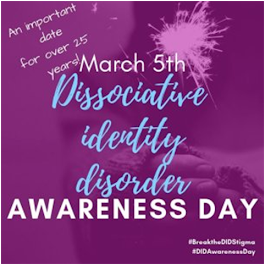DISSOCIATIVE IDENTITY DISORDER AWARENESS DAY
Dissociative identity disorder is also
known as multiple personality.

It
is a relatively new disorder that psychiatrists have been learning about as it
often goes un diagnosed among the general population.
Today researcher has shown the existence of
the disorder but due to its rarity in many cases, not many would known about
the disorder.
AIMS OF DISSOCIATIVE IDENTITY DISORDER AWARENESS DAY:
· To change those fears by spreading
awareness of its existence to today’s society.
· Helps to bring about education &
success through understanding & compassion.
· To change that fact & make it more
known through out the world as a valid condition that should be understood by
others.
INCIDENCE:
According to the national alliance of
mental illness, only 2% of the united states experience thee symptoms &
have been properly diagnosed.

GOALS:
· It can be a way to empower them, help
share their stories & learn better ways of loving & accepting
themselves in a world where this kind of disorder is not well known or
understood.
· The second goal in mind is to raise
awareness about the disorder itself, helps others understood what it means to
have dissociative identity disorder & learn better ways of managing the
disorder in life.
OVER
VIEW ABOUT DISSOCIATIVE IDENTITY DISODER:
It is a mental disorder characterized by the
maintenance of at least two distinct & relatively enduring personality
states. These personalities control their behavior at different times.
These
disorder affect a person’s ability to connect with reality.

The
disorder affects between 0.01%&1% of the population. It can occur at any
age women are more likely than men.
TYPES:
DEPERSONALIZED DISORDER:
Feeling
of detachment from your actions.
DISSOCIATIVE AMNESIA:
Problems
remembering information about yourself.
CAUSES:

Severe
trauma during early childhood.
Extreme,
repetitive physical & emotional abuse.
SYMPTOMS:
BEHAVIORAL:
Impulsivity, self destructive
behavior, or self harm.
MOOD:
Anxiety, feeling detached from self
or mood swings.

PSYCHOLOGICAL:
Altered
consciousness, depression or flash back.
TREATMENT:
Focus
on identifying & working through past trauma or abuse.

Managing
sudden behavioral changes.
Merging separate identities in to single
identity.
Psychotherapy.
Cognitive
behavioral therapy.
Family
therapy.





0 Comments